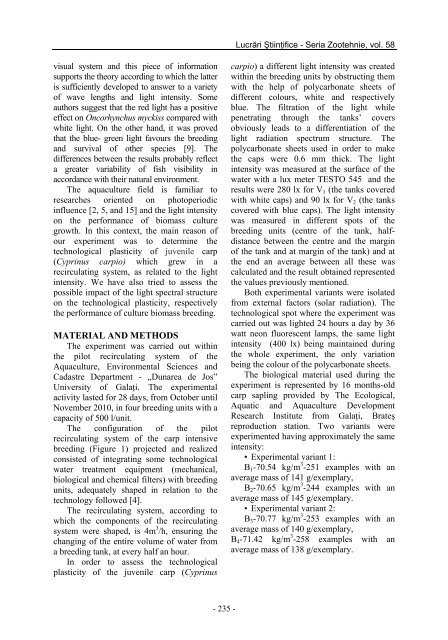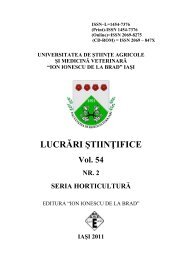the influence of light intensity on the growth performance of common ...
the influence of light intensity on the growth performance of common ...
the influence of light intensity on the growth performance of common ...
Create successful ePaper yourself
Turn your PDF publications into a flip-book with our unique Google optimized e-Paper software.
visual system and this piece <str<strong>on</strong>g>of</str<strong>on</strong>g> informati<strong>on</strong><br />
supports <str<strong>on</strong>g>the</str<strong>on</strong>g> <str<strong>on</strong>g>the</str<strong>on</strong>g>ory according to which <str<strong>on</strong>g>the</str<strong>on</strong>g> latter<br />
is sufficiently developed to answer to a variety<br />
<str<strong>on</strong>g>of</str<strong>on</strong>g> wave lengths and <str<strong>on</strong>g>light</str<strong>on</strong>g> <str<strong>on</strong>g>intensity</str<strong>on</strong>g>. Some<br />
authors suggest that <str<strong>on</strong>g>the</str<strong>on</strong>g> red <str<strong>on</strong>g>light</str<strong>on</strong>g> has a positive<br />
effect <strong>on</strong> Oncorhynchus myckiss compared with<br />
white <str<strong>on</strong>g>light</str<strong>on</strong>g>. On <str<strong>on</strong>g>the</str<strong>on</strong>g> o<str<strong>on</strong>g>the</str<strong>on</strong>g>r hand, it was proved<br />
that <str<strong>on</strong>g>the</str<strong>on</strong>g> blue- green <str<strong>on</strong>g>light</str<strong>on</strong>g> favours <str<strong>on</strong>g>the</str<strong>on</strong>g> breeding<br />
and survival <str<strong>on</strong>g>of</str<strong>on</strong>g> o<str<strong>on</strong>g>the</str<strong>on</strong>g>r species [9]. The<br />
differences between <str<strong>on</strong>g>the</str<strong>on</strong>g> results probably reflect<br />
a greater variability <str<strong>on</strong>g>of</str<strong>on</strong>g> fish visibility in<br />
accordance with <str<strong>on</strong>g>the</str<strong>on</strong>g>ir natural envir<strong>on</strong>ment.<br />
The aquaculture field is familiar to<br />
researches oriented <strong>on</strong> photoperiodic<br />
<str<strong>on</strong>g>influence</str<strong>on</strong>g> [2, 5, and 15] and <str<strong>on</strong>g>the</str<strong>on</strong>g> <str<strong>on</strong>g>light</str<strong>on</strong>g> <str<strong>on</strong>g>intensity</str<strong>on</strong>g><br />
<strong>on</strong> <str<strong>on</strong>g>the</str<strong>on</strong>g> <strong>performance</strong> <str<strong>on</strong>g>of</str<strong>on</strong>g> biomass culture<br />
<strong>growth</strong>. In this c<strong>on</strong>text, <str<strong>on</strong>g>the</str<strong>on</strong>g> main reas<strong>on</strong> <str<strong>on</strong>g>of</str<strong>on</strong>g><br />
our experiment was to determine <str<strong>on</strong>g>the</str<strong>on</strong>g><br />
technological plasticity <str<strong>on</strong>g>of</str<strong>on</strong>g> juvenile carp<br />
(Cyprinus carpio) which grew in a<br />
recirculating system, as related to <str<strong>on</strong>g>the</str<strong>on</strong>g> <str<strong>on</strong>g>light</str<strong>on</strong>g><br />
<str<strong>on</strong>g>intensity</str<strong>on</strong>g>. We have also tried to assess <str<strong>on</strong>g>the</str<strong>on</strong>g><br />
possible impact <str<strong>on</strong>g>of</str<strong>on</strong>g> <str<strong>on</strong>g>the</str<strong>on</strong>g> <str<strong>on</strong>g>light</str<strong>on</strong>g> spectral structure<br />
<strong>on</strong> <str<strong>on</strong>g>the</str<strong>on</strong>g> technological plasticity, respectively<br />
<str<strong>on</strong>g>the</str<strong>on</strong>g> <strong>performance</strong> <str<strong>on</strong>g>of</str<strong>on</strong>g> culture biomass breeding.<br />
MATERIAL AND METHODS<br />
The experiment was carried out within<br />
<str<strong>on</strong>g>the</str<strong>on</strong>g> pilot recirculating system <str<strong>on</strong>g>of</str<strong>on</strong>g> <str<strong>on</strong>g>the</str<strong>on</strong>g><br />
Aquaculture, Envir<strong>on</strong>mental Sciences and<br />
Cadastre Department - „Dunarea de Jos”<br />
University <str<strong>on</strong>g>of</str<strong>on</strong>g> Galaţi. The experimental<br />
activity lasted for 28 days, from October until<br />
November 2010, in four breeding units with a<br />
capacity <str<strong>on</strong>g>of</str<strong>on</strong>g> 500 l/unit.<br />
The c<strong>on</strong>figurati<strong>on</strong> <str<strong>on</strong>g>of</str<strong>on</strong>g> <str<strong>on</strong>g>the</str<strong>on</strong>g> pilot<br />
recirculating system <str<strong>on</strong>g>of</str<strong>on</strong>g> <str<strong>on</strong>g>the</str<strong>on</strong>g> carp intensive<br />
breeding (Figure 1) projected and realized<br />
c<strong>on</strong>sisted <str<strong>on</strong>g>of</str<strong>on</strong>g> integrating some technological<br />
water treatment equipment (mechanical,<br />
biological and chemical filters) with breeding<br />
units, adequately shaped in relati<strong>on</strong> to <str<strong>on</strong>g>the</str<strong>on</strong>g><br />
technology followed [4].<br />
The recirculating system, according to<br />
which <str<strong>on</strong>g>the</str<strong>on</strong>g> comp<strong>on</strong>ents <str<strong>on</strong>g>of</str<strong>on</strong>g> <str<strong>on</strong>g>the</str<strong>on</strong>g> recirculating<br />
system were shaped, is 4m 3 /h, ensuring <str<strong>on</strong>g>the</str<strong>on</strong>g><br />
changing <str<strong>on</strong>g>of</str<strong>on</strong>g> <str<strong>on</strong>g>the</str<strong>on</strong>g> entire volume <str<strong>on</strong>g>of</str<strong>on</strong>g> water from<br />
a breeding tank, at every half an hour.<br />
In order to assess <str<strong>on</strong>g>the</str<strong>on</strong>g> technological<br />
plasticity <str<strong>on</strong>g>of</str<strong>on</strong>g> <str<strong>on</strong>g>the</str<strong>on</strong>g> juvenile carp (Cyprinus<br />
- 235 -<br />
Lucrări Ştiinţifice - Seria Zootehnie, vol. 58<br />
carpio) a different <str<strong>on</strong>g>light</str<strong>on</strong>g> <str<strong>on</strong>g>intensity</str<strong>on</strong>g> was created<br />
within <str<strong>on</strong>g>the</str<strong>on</strong>g> breeding units by obstructing <str<strong>on</strong>g>the</str<strong>on</strong>g>m<br />
with <str<strong>on</strong>g>the</str<strong>on</strong>g> help <str<strong>on</strong>g>of</str<strong>on</strong>g> polycarb<strong>on</strong>ate sheets <str<strong>on</strong>g>of</str<strong>on</strong>g><br />
different colours, white and respectively<br />
blue. The filtrati<strong>on</strong> <str<strong>on</strong>g>of</str<strong>on</strong>g> <str<strong>on</strong>g>the</str<strong>on</strong>g> <str<strong>on</strong>g>light</str<strong>on</strong>g> while<br />
penetrating through <str<strong>on</strong>g>the</str<strong>on</strong>g> tanks’ covers<br />
obviously leads to a differentiati<strong>on</strong> <str<strong>on</strong>g>of</str<strong>on</strong>g> <str<strong>on</strong>g>the</str<strong>on</strong>g><br />
<str<strong>on</strong>g>light</str<strong>on</strong>g> radiati<strong>on</strong> spectrum structure. The<br />
polycarb<strong>on</strong>ate sheets used in order to make<br />
<str<strong>on</strong>g>the</str<strong>on</strong>g> caps were 0.6 mm thick. The <str<strong>on</strong>g>light</str<strong>on</strong>g><br />
<str<strong>on</strong>g>intensity</str<strong>on</strong>g> was measured at <str<strong>on</strong>g>the</str<strong>on</strong>g> surface <str<strong>on</strong>g>of</str<strong>on</strong>g> <str<strong>on</strong>g>the</str<strong>on</strong>g><br />
water with a lux meter TESTO 545 and <str<strong>on</strong>g>the</str<strong>on</strong>g><br />
results were 280 lx for V1 (<str<strong>on</strong>g>the</str<strong>on</strong>g> tanks covered<br />
with white caps) and 90 lx for V 2 (<str<strong>on</strong>g>the</str<strong>on</strong>g> tanks<br />
covered with blue caps). The <str<strong>on</strong>g>light</str<strong>on</strong>g> <str<strong>on</strong>g>intensity</str<strong>on</strong>g><br />
was measured in different spots <str<strong>on</strong>g>of</str<strong>on</strong>g> <str<strong>on</strong>g>the</str<strong>on</strong>g><br />
breeding units (centre <str<strong>on</strong>g>of</str<strong>on</strong>g> <str<strong>on</strong>g>the</str<strong>on</strong>g> tank, halfdistance<br />
between <str<strong>on</strong>g>the</str<strong>on</strong>g> centre and <str<strong>on</strong>g>the</str<strong>on</strong>g> margin<br />
<str<strong>on</strong>g>of</str<strong>on</strong>g> <str<strong>on</strong>g>the</str<strong>on</strong>g> tank and at margin <str<strong>on</strong>g>of</str<strong>on</strong>g> <str<strong>on</strong>g>the</str<strong>on</strong>g> tank) and at<br />
<str<strong>on</strong>g>the</str<strong>on</strong>g> end an average between all <str<strong>on</strong>g>the</str<strong>on</strong>g>se was<br />
calculated and <str<strong>on</strong>g>the</str<strong>on</strong>g> result obtained represented<br />
<str<strong>on</strong>g>the</str<strong>on</strong>g> values previously menti<strong>on</strong>ed.<br />
Both experimental variants were isolated<br />
from external factors (solar radiati<strong>on</strong>). The<br />
technological spot where <str<strong>on</strong>g>the</str<strong>on</strong>g> experiment was<br />
carried out was <str<strong>on</strong>g>light</str<strong>on</strong>g>ed 24 hours a day by 36<br />
watt ne<strong>on</strong> fluorescent lamps, <str<strong>on</strong>g>the</str<strong>on</strong>g> same <str<strong>on</strong>g>light</str<strong>on</strong>g><br />
<str<strong>on</strong>g>intensity</str<strong>on</strong>g> (400 lx) being maintained during<br />
<str<strong>on</strong>g>the</str<strong>on</strong>g> whole experiment, <str<strong>on</strong>g>the</str<strong>on</strong>g> <strong>on</strong>ly variati<strong>on</strong><br />
being <str<strong>on</strong>g>the</str<strong>on</strong>g> colour <str<strong>on</strong>g>of</str<strong>on</strong>g> <str<strong>on</strong>g>the</str<strong>on</strong>g> polycarb<strong>on</strong>ate sheets.<br />
The biological material used during <str<strong>on</strong>g>the</str<strong>on</strong>g><br />
experiment is represented by 16 m<strong>on</strong>ths-old<br />
carp sapling provided by The Ecological,<br />
Aquatic and Aquaculture Development<br />
Research Institute from Galaţi, Brateş<br />
reproducti<strong>on</strong> stati<strong>on</strong>. Two variants were<br />
experimented having approximately <str<strong>on</strong>g>the</str<strong>on</strong>g> same<br />
<str<strong>on</strong>g>intensity</str<strong>on</strong>g>:<br />
• Experimental variant 1:<br />
B1-70.54 kg/m 3 -251 examples with an<br />
average mass <str<strong>on</strong>g>of</str<strong>on</strong>g> 141 g/exemplary,<br />
B2-70.65 kg/m 3 -244 examples with an<br />
average mass <str<strong>on</strong>g>of</str<strong>on</strong>g> 145 g/exemplary.<br />
• Experimental variant 2:<br />
B 3-70.77 kg/m 3 -253 examples with an<br />
average mass <str<strong>on</strong>g>of</str<strong>on</strong>g> 140 g/exemplary,<br />
B4-71.42 kg/m 3 -258 examples with an<br />
average mass <str<strong>on</strong>g>of</str<strong>on</strong>g> 138 g/exemplary.









